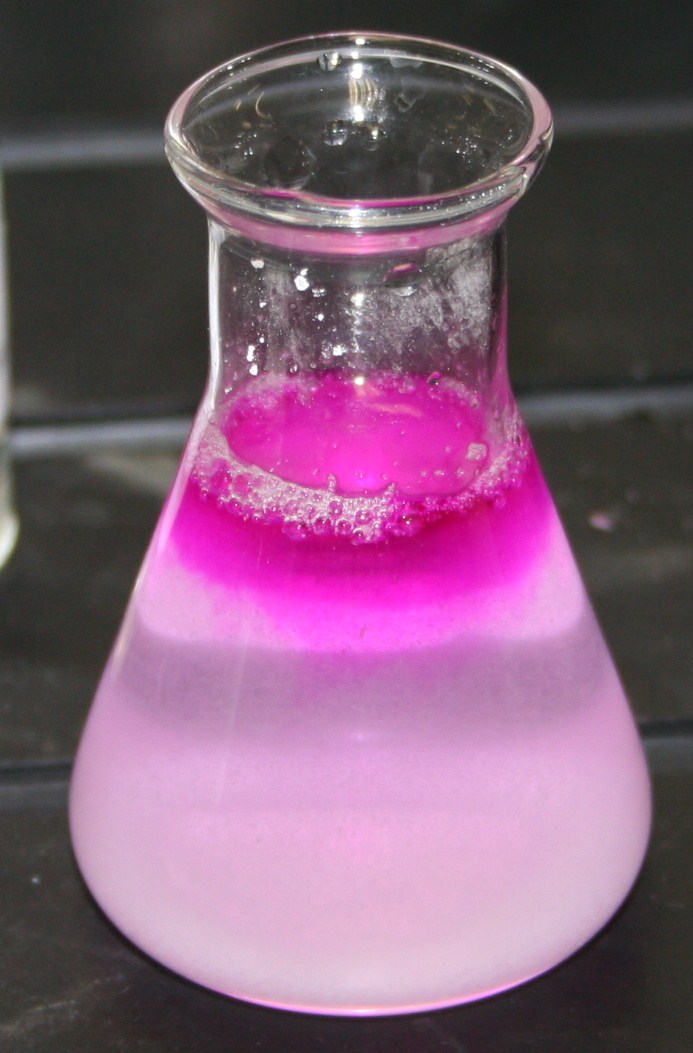|
Phenolphthalein
Phenolphthalein ( ) is a chemical compound with the formula C20 H14 O4 and is often written as "HIn", "HPh", "phph" or simply "Ph" in shorthand notation. Phenolphthalein is often used as an indicator in acid–base titrations. For this application, it turns colorless in acidic solutions and pink in basic solutions. It belongs to the class of dyes known as phthalein dyes. Phenolphthalein is slightly soluble in water and usually is dissolved in alcohols for use in experiments. It is a weak acid, which can lose H+ ions in solution. The nonionized phenolphthalein molecule is colorless and the double deprotonated phenolphthalein ion is fuchsia. Further loss of proton in higher pH occurs slowly and leads to a colorless form. Phenolphthalein ion in concentrated sulfuric acid is orange red due to sulfonation. Uses pH indicator Phenolphthalein's common use is as an indicator in acid-base titrations. It also serves as a component of universal indicator, together with methyl red, ... [...More Info...] [...Related Items...] OR: [Wikipedia] [Google] [Baidu] |
Phthalein Dyes
Phthalein dyes are a class of dyes mainly used as pH indicators, due to their ability to change colors depending on pH. They are formed by the reaction of phthalic anhydride with various phenols. They are a subclass of triarylmethane dyes. Common phthalein dyes include: *Bromothymol blue * Bromocresol green * Bromocresol purple * Cresol Red * ''o''-Cresolphthalein * Chlorophenol red * Dixylenolphthalein * Guaiacolphthalein * α-Naphtholphthalein * Phenolphthalein Phenolphthalein ( ) is a chemical compound with the formula C20 H14 O4 and is often written as "HIn", "HPh", "phph" or simply "Ph" in shorthand notation. Phenolphthalein is often used as an indicator in acid–base titrations. For this applic ... * Phenolsulfonphthalein * Tetrabromophenolphthalein * Thymol blue * Thymolphthalein * Xylenolphthalein See also * Triarylmethane dye References Triarylmethane dyes Phthalides {{organic-compound-stub ... [...More Info...] [...Related Items...] OR: [Wikipedia] [Google] [Baidu] |
Bromothymol Blue
Bromothymol blue (also known as bromothymol sulfone phthalein and BTB) is a pH indicator. It is mostly used in applications that require measuring substances that would have a relatively neutral pH (near 7). A common use is for measuring the presence of carbonic acid in a liquid. It is typically sold in solid form as the sodium salt of the acid indicator. Structure and properties Bromothymol blue acts as a weak acid in a solution. It can thus be in protonated or deprotonated form, appearing yellow or blue, respectively. It is bright aquamarine by itself, and greenish-blue in a neutral solution. The deprotonation of the neutral form results in a highly conjugated structure, accounting for the difference in color. An intermediate of the deprotonation mechanism is responsible for the greenish color in neutral solution. The protonated form of bromothymol blue has its peak absorption at 427 nm thus transmitting yellow light in acidic solutions, and the deprotonated form has ... [...More Info...] [...Related Items...] OR: [Wikipedia] [Google] [Baidu] |
Acid–base Titration
An acid–base titration is a method of quantitative analysis for determining the concentration of an acid or base by exactly neutralizing it with a standard solution of base or acid having known concentration. A pH indicator is used to monitor the progress of the acid–base reaction. If the acid dissociation constant (p''K''a) of the acid or base dissociation constant (p''K''b) of base in the analyte solution is known, its solution concentration (molarity) can be determined. Alternately, the p''K''a can be determined if the analyte solution has a known solution concentration by constructing a titration curve. Alkalimetry and acidimetry Alkalimetry and acidimetry are a kind of volumetric analysis in which the fundamental reaction is a neutralization reaction. Acidimetry is the specialized analytic use of acid-base titration to determine the concentration of a basic (synonymous to alkaline) substances using standard acid. Alkalimetry, is the same concept of specialized analyti ... [...More Info...] [...Related Items...] OR: [Wikipedia] [Google] [Baidu] |
Universal Indicator
__FORCETOC__ A universal indicator is a pH indicator made of a solution of several compounds that exhibits several smooth colour changes over a wide range pH values to indicate the acidity or alkalinity of solutions. Although there are several commercially available universal pH indicators, most are a variation of a formula patented by Yamada in 1933. Details of this patent can be found in ''Chemical Abstracts''. Experiments with Yamada's universal indicator are also described in the ''Journal of Chemical Education''. A universal indicator is usually composed of water, 1-propanol, phenolphthalein, sodium hydroxide, methyl red, bromothymol blue, sodium bisulfite, and thymol blue. The colours that indicate the pH of a solution, after adding a universal indicator, are The colours from yellow to red indicate an acidic solution, colours blue to violet indicate an alkaline solution and a green colour indicates that a solution is neutral. Wide-range pH test papers with disti ... [...More Info...] [...Related Items...] OR: [Wikipedia] [Google] [Baidu] |

